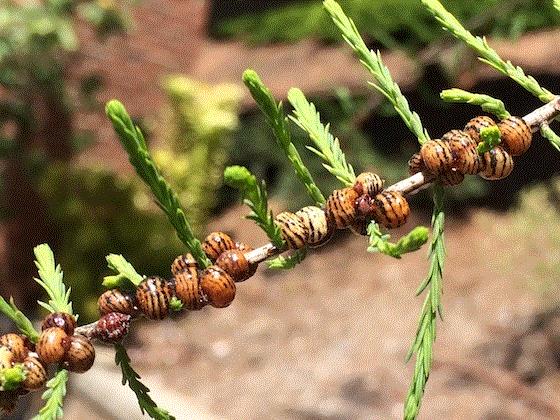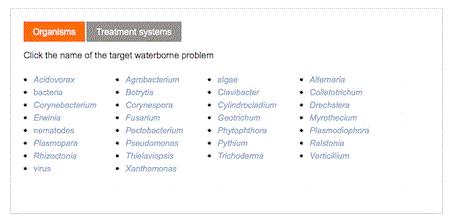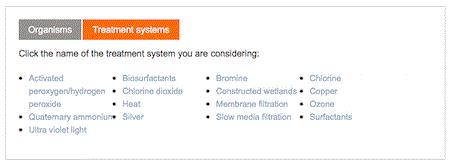Last week's "What the ... ?"
I quizzed y’all on a creature that looks like stripey gumdrops on bald cypress. Many sent in answers and guesses; thank you! I love it when we have a chance to play a game and for me to know that many of you are reading and enjoying this newsletter. I need that boost in confidence, especially after spending a five-day sumer field trip with undergraduates who wear the same “I-am-somewhere-else” look from Monday to Friday. Sigh.
My best guess of the mystery creature is (drum roll) the European fruit lecanium, Parthenolecanium corni. The gumdrops are actually young adult females. That’s “my best guess,” because there’s another possibility: Fletcher scale, Parthenolecanium fletcheri, is also stripey at times and very common on conifers. You know the two species are first cousins by the same genus name. I think it’s more likely the European fruit lecanium because the stripes are more numerous and complete on the gumdrops. Yes, my reason was THAT scientific.

These stripey gumdrops on bald cypress are (most probably) young adult European fruit lecanium. (Photo courtesy of Bob Polomski, Clemson University)
Identification of scale insects is not for the faint-of-heart. The process of distinguishing the European fruit lecanium from Fletcher scale is laborious. You start by collecting young adult females. Then you process the insects in a chemical bath for days, mount the processed specimens on glass slides, look at them under the microscopes, and find the dorsal tubular ducts and marginal setae.
If you go, “HUH??!! Dorsal what?,” I totally understand. I do this for a living and I still go “HUH?? What the … ?,” constantly. It’s a miracle that most scale insect taxonomists (nerds who identify and categorize scale insects) I’m acquainted with still have their hair. Or, are those toupees?
What threw me off in this case were those stripes. Truthfully, this is the first time I’ve seen such vivid stripes on young adult females. Adult females of this age have just begun to swell up and haven't produced any eggs; this stage usually lasts only three to four days in the scale insect’s one-year life cycle. (Good job in being there at the right time, Bob!) As soon as the females begin to produce eggs, the scale covers harden and darken, thus diminishing the stripes. At this point, all females become the brown, globular European fruit lecanium scales we’re familiar with.
So, those who answered European fruit lecanium or Fletcher scale won this game! The winners are Kerrie of Clemson Extension, Lindsay of Saunders Brothers, Sandy of Penn State Extension, Andrew of Charlottesville, Virginia, Dave of Schenck Farms and Greenhouses and Jonathan of Busby’s Landscaping. And most impressively, Jim Borland of Denver, Colorado, strikes again and becomes our reigning champion! Great job, everyone!

Time to put in place a management plan for soft scales
May is here. Temperature is going to hit 90F at home tomorrow. Folks are working in their lawns and gardens, and plants are flying off the shelves. How good are sales? Bossman Beytes can tell you in his most recent Acres Online.
You know what else warmer temperature brings? Bugs! And JC’s smirks. I grew up in a tropical country so I thrive in heat and humidity. Hard for me to understand why everyone around me looks like they’re melting. My wife bans me from smirking, but I manage to sneak in a couple when she’s not watching, just for my mental health.
Soft scales are getting fat and full of eggs in my neck of the woods. Soon, the eggs will hatch and y’all better have a plan in place to deal with the emergence of millions of crawlers.
My general recommendation on (soft and armored) scale insect management depends on knowing where the scale insects feed.
If you’re dealing with a scale insect species that feeds exclusively or spends at least part of its life on leaves, systemic insecticides (such as neonicotinoids) usually work well. In this case, you can apply the systemic insecticides to the root zone by granule, drench or injection, or to the trunk by basal trunk spray.
Systemic insecticide application is particularly useful for large trees, which could be challenging to spray. The systemic insecticides, after being taken up by roots, will concentrate on the leaves, be ingested by the scale insect nymphs and do a good job of killing them. The efficacy is greater against nymphs than it is against adults. Application can be made after you see those fat females until August. One application per year is sufficient.
Of course, you may choose to manage these leaf-feeding scale insects with foliar spray if the application is logistically feasible. You may also prefer not to use systemic insecticides, or you’re treating a pollinator-attractive plant or dealing with a scale insect species that feeds exclusively on twigs, branches and trunks. For these situations, I recommend making multiple sprays (two or three weeks between consecutive sprays) of 1% to 2% horticultural oil, an insect growth regulator (Talus, Distance or Fulcrum) or a tank mix of horticultural oil and insect growth regulator.
I recommend horticultural oil and insect growth regulators for sprays because they’re effective against crawlers and nymphs, they have some efficacy against adults, and they’re “soft” on the diverse and abundant natural enemies that attack scale insects. However, these products have shorter residue and you need to target crawlers and nymphs. So, treatment should begin when crawlers are first detected and continue until the end of crawler emergence. Many scale insect species produce crawlers continuously for a month or longer (hence multiple sprays are needed).
You’ll need two pieces of information to make the most of my recommendation.
First, you’ll need to know where the scale insects hang out. Each scale insect species has its own peculiarities in biology. Some species feed exclusively on woody tissues (such as gloomy scale), some like leaves only (such as tea scale), some spend their youth on the leaves and adulthood on the woody tissues (such as European fruit lecanium) and some are all over the place (such as Florida wax scale). You’ll need to know where the scale insects feed in order to choose the right approach.
Second, if you choose to spray, you’ll need to know when eggs hatch or crawlers emerge. That means you will need to know the scale insect species because each species has its own voltinism (i.e. the number of generations per year) and reproductive times. My former PhD student Ernesto Robayo Camacho and I published a review paper several years ago summarizing information on the voltinism, crawler emergence times and management of soft scales in the world. There are still a lot of unknowns because studies on the life cycle of soft scales haven’t been conducted at every place and on every host plant in the world. If you want a copy of the paper, send me an email. My colleagues and I are planning for a similar paper on armored scales.
Crawler emergence times change from year to year and from location to location depending on temperature the scale insects experienced. The best way to find out when crawlers emerge is to do the monitoring yourself. This can easily be done in two ways. The first method involves flipping over a few scale insect covers every week and see if they have laid eggs. Alternatively, you can wrap a black electrical tape (sticky side out) around a few infested branches and check them weekly to see if crawlers are stuck to the tape. Both monitoring methods should begin a few weeks before the historical emergence date (if known). Begin treatment as soon as crawlers are found.
Scale insects are difficult to manage. Be persistent and patient because successful management often takes several years of treatment regardless of which of my two approaches you take.

Waterborne solutions for your waterborne disease management
Paul Fisher of University of Florida introduced me to a disease management tool developed by the CleanWateR3 team called Waterborne solutions. This tool summarizes current research on using water treatment technologies and products to reduce plant pathogens and diseases.
I played with the Waterborne solutions tool and I love it!
I clicked Erwinia under the “Organisms” tab and out came several options for reducing Erwinia on ornamental plants: bromine, hypochlorous acid, chlorine dioxide, copper ionization and heat, along with details on pathogen species, plant species, dosages and results of the studies.

The "Organisms" tab in Waterborne solutions.
Then, I clicked on the “Treatment systems” tab, and selected “Ozone.” The tool showed me a list of pathogen genera that had been evaluated, with details on dosages of ozone, treatment time and treatment results for each pathogen species.

The "Treatment systems" tab on Waterborne solutions.
I’m going to introduce this tool to Ed, my local orchid grower, PDQ (pretty darn quick). Ed has been fighting Erwinia for some time. I’m sure he’ll be tickled to death by this tool.
I’m sure this tool will also be useful to you. Remember that diseases are best managed in an integrated manner, with water treatment and fungicides being part of the program. It’s also important to keep an eye on the moisture in the medium, temperature, humidity, airflow, etc.

Other nifty tools
In addition to the Waterborne solutions, you can also find several useful interactive tools and calculators under the “tools” box on the CleanWateR3 web page.
The first one is WaterQual tool, which interprets water quality tests for you. Matthew Chappell tried it. See what he thought about it in his Nursery and Landscape Insider.
The “parts per million to recipe” and the “recipe to parts per million” calculators (provided by Back Pocket Grower) can help you prepare sanitizing chemicals and water-soluble fertilizers. I’m often confused and miss a step somewhere during the process of calculating how much water-soluble 20-20-20 I need to make a stock solution. This tool definitely helps.
The Alkalinity Calculator (by University of New Hampshire Extension Service) provides recommendations on the amount of acid you need to adjust irrigation water pH. Input your target pH or alkalinity, pH or alkalinity of your sample and the type and concentration of acid you would like to use, click “submit sample”, and (ta-da) you get a recommendation. That made JC says, “Sweet!”
The Pipe Volume Calculator (by handymath.com) helps you calculate the volume of your pipes and mixing tanks. For example, if you want to find out the length of a 2-ft diameter cylinder to give you 150 gallons of storing capacity, you can just input “2” in the diameter cell, “150” in the volume cell, and click “calculate”. By the way, the answer is 6.4 ft.
GroZone Tracker is a free web-based app that helps growers collect and review substrate pH and electrical conductivity and water alkalinity. The app is developed by Jim Owen of Virginia Tech, Brian Whipker of North Carolina State University, Sarah White of Clemson University and Brian Krug at Pioneer Hybrids. The app will allow growers determine if their substrate pH, EC and alkalinity are within desired ranges to avoid any problems. GroZone Tracker can do a lot more than what I can tell you in this newsletter. So, try out the free app.
Boy, my head is filled with new, useful stuff. That’s pretty awesome!





See y'all next time!

JC Chong
Associate Professor of Entomology at Clemson University
This e-mail received by 24,525 subscribers like you!
If you're interested in advertising on PestTalks contact Kim Brown ASAP!